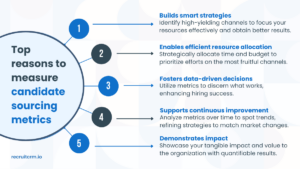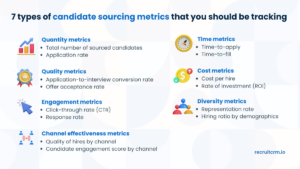Feeling stuck in the endless cycle of recruiting without results?
You are not alone, with a recent SHRM report indicating that 83% of global employers share your frustration.
So what’s the solution?
Staying focused on well-defined metrics that really help you improve hiring performance.
So let’s break down on these 14 key candidate sourcing metrics guaranteed to change how you hire.
What are candidate sourcing metrics?
Candidate sourcing metrics help recruiters assess the different aspects of attracting potential candidates, clearly indicating the effectiveness of their hiring strategies.
From the moment a position becomes open to the point of shortlisting talent, these metrics track and analyze the performance of sourcing channels, the quality of candidates, and the efficiency of the overall process.
They go beyond gut feelings and assumptions, offering concrete and objective evidence of what’s working and what needs improvement.
You might also like: Top 3 recruitment metrics recruiters must look into
Why should you consider measuring them?
For years, recruiters have depended on personal judgment, team expertise, and traditional methods to identify potential candidates.
So, why do we need candidate sourcing metrics now? Let’s understand why these data insights are the key to recruitment success:

- Helps build smart sourcing strategies: Sourcing metrics enable you to identify the channels that consistently yield high-quality candidates. This insight empowers you to allocate your resources wisely, focusing your efforts on platforms that yield the best results.
- Aids efficient resource allocation: With valuable data in hand, you can strategically allocate your time and budget. Instead of spreading yourself across random job boards and hiring platforms, you can concentrate your efforts where they matter most.
- Promotes data-backed decision-making: Analyzing metrics proves what’s working and what’s not. With this, you can make more data-driven decisions, boosting hiring success and improving strategies.
- Leads to continuous improvement: Regularly tracking and analyzing candidate sourcing metrics allows you to identify trends and patterns over time. This information is invaluable for refining your strategies and adapting to changing market dynamics.
- Offers demonstrable impact: Showcasing your impact to clients and hiring managers is crucial. By leveraging sourcing metrics, you can present quantifiable results to stakeholders, demonstrating your value to the organization.
Recruitment demands precision.
Measuring these metrics is your toolkit for making strategic and data-driven choices that lead to successful hires.
You might also like: Candidate sourcing 101: A guide to sourcing the best talent
7 types of candidate sourcing metrics that you should be tracking

1. Quantity metrics
Quantity metrics focus on the sheer volume of candidates your sourcing efforts bring in.
They help you gauge the effectiveness of your outreach and the extent of your candidate pool.
There are two key quantity metrics that you must pay attention to:
- Total number of sourced candidates: This quantity metric focuses on the performance of different sourcing channels.
It involves tracking the number of candidates sourced from each channel, such as job boards, social media, referrals, and direct sourcing.
By analyzing the performance of various sourcing channels, you can identify which channels generate the most candidates and which require optimization.
For instance, if social media platforms consistently drive a higher volume of candidates than traditional job boards, you might consider allocating more resources to your social media sourcing strategy.
- Application rate: Application rate provides insights into the effectiveness of your job postings and sourcing channels.
You can calculate it by dividing the number of submitted applications by the total number of candidates who viewed the job posting.
A higher application rate indicates that your job posting resonates with candidates and encourages them to take action.
Whereas a lower application rate suggests that your job posting needs refinement or the job requirements don’t align with candidate preferences.
2. Quality metrics
Quality metrics offer a clear lens through which you can assess the caliber of candidates you attract and how well they align with your organization’s needs.
They help you differentiate between candidates who merely fill a position and those who elevate your team.
Here are the top two quality metrics that you should be familiar with:
- Application-to-interview conversion rate: This metric calculates the percentage of candidates who move from the application stage to being invited for an interview.
A high conversion rate suggests that your sourcing strategies attract candidates whose qualifications align closely with your job requirements.
On the other hand, a lower conversion rate might signal that adjustments are needed in your sourcing platforms or job descriptions to attract more suitable candidates.
- Offer acceptance rate: The job offer acceptance rate reflects the attractiveness of your job offers to potential candidates. It reveals the percentage of candidates who accept the job offers extended to them.
A high acceptance rate signifies that your sourcing efforts successfully identify candidates who find your organization and the offered role appealing.
A lower acceptance rate might indicate that you need to tailor your job offers to align better with the candidate’s expectations. Look at competitors’ job offers or collect feedback from these candidates for a better outlook.
You might also like: 10 sourcing email templates you can use to reach out to candidates
3. Engagement metrics

Engagement metrics reveal how candidates are interacting with your recruitment efforts. They provide insights into the level of interest candidates have in your job opportunities and employer brand.
By analyzing engagement metrics, you gain a deeper understanding of candidate behavior and preferences, enabling you to refine your strategies and create a more engaging candidate experience.
The top engagement metrics include:
- Click-through rate: CTR measures the percentage of candidates who click on a link or call to action in your job postings or emails.
It displays how compelling your content is and whether candidates find your offerings intriguing enough to take further action.
A higher CTR suggests that your messaging resonates well with your target audience. Consider rewording the title or incorporating more exciting details and keywords if you receive a low CTR.
- Response rate: Response rate is a simple measure of how many candidates you reach out to actually respond to your communication. It’s a way to gauge how effective your outreach efforts are in getting a reaction from potential candidates.
High response rates indicate that your messages capture candidates’ interests and prompt them to engage with you.
On the other hand, a low response rate could indicate that your outreach needs some adjustments.
4. Channel effectiveness metrics
These metrics assess the performance of different sourcing channels to identify which ones yield the best results. They highlight critical aspects such as candidate reach, engagement levels, conversion rates, and overall ROI.
By closely monitoring these metrics, you can allocate resources and tailor your strategies to focus on the most fruitful channels.
Here are a couple of crucial channel effectiveness metrics:
- Quality of hires by channel: This metric allows recruiters to gain insights into the long-term impact of their sourcing strategies on the organization’s performance.
It involves evaluating factors such as a candidate’s performance, productivity, retention rates, cultural fit, skill set alignment, career growth, and interview feedback from managers and colleagues.
By analyzing the quality of hires across various channels, recruiters can identify which channels consistently deliver candidates who excel in their roles, contribute to the organization’s goals, and integrate well with the team and culture.
- Candidate engagement score by channel: This metric assesses candidate engagement across various sourcing channels. It considers factors like views, interactions, and time spent on your content or careers page.
By assigning a numerical score, recruiters can compare the engagement levels of different channels.
A higher engagement score indicates that candidates find the content compelling and are more likely to explore opportunities further.
5. Time metrics
Time metrics provide insights into the speed and efficiency of your sourcing efforts.
The speed at which a role is filled greatly impacts an organization’s success. Prolonged vacancies can lead to increased workload on existing employees, decreased productivity, and potential revenue loss.
On the flip side, too rapid a recruitment process results in hiring subpar candidates. Time metrics help strike the right balance between these extremes.
Key time metrics include:
- Time-to-apply: Time-to-apply is the duration it takes for a candidate to complete the application process once they initiate it. This metric reflects the ease of your application process and the level of interest candidates have in your opportunities.
A shorter application time indicates that your application process is user-friendly and doesn’t discourage candidates. If the average time to apply is longer than expected, it could indicate that candidates encounter excessive steps or obstacles in the application process.
- Time-to-fill: The time-to-fill metric sheds light on the efficiency of various sourcing channels in delivering suitable candidates within the desired time frame.
This metric quantifies the duration it takes to move from initiating the recruitment process to successfully filling a vacant position.
Analyzing this metric is vital if you want to streamline and fast-track your hiring process.
You might also like: 10 candidate sourcing strategies that recruiters can use this season
6. Cost metrics
Cost metrics assess the financial implications of your sourcing efforts. They go beyond the surface-level expenditure by indicating costs associated with attracting, evaluating, and onboarding new talent.
By understanding direct and indirect financial implications, recruiters can strategically allocate resources and ensure a more budget-friendly hiring process.
Cost metrics encompass a range of factors, including:
- Cost per hire: Cost per hire calculates total recruitment-related expenses incurred to fill a position.
This metric includes direct costs like advertising, agency fees, and background checks and indirect costs such as time recruiters spend on interviews and evaluations.
- Rate of investment: ROI shows the efficiency and profitability of an investment. This metric helps recruiters determine whether the resources and efforts invested in sourcing, hiring, and onboarding candidates yield favorable outcomes.

Here, the “net gain from investment” includes factors such as value added by new hires, impact on team performance, and contribution of candidates to the organization’s goals. The “cost of investment” encompasses all the direct and indirect recruitment costs.
7. Diversity metrics
Diversity metrics focus on tracking the inclusivity of your sourcing efforts and candidate pool.
With 74% of millennial employees expressing value for a diverse and inclusive culture, diversity hiring has become a sheer necessity for recruiters today.
By collecting and analyzing the following metrics, organizations can foster an inclusive workspace:
- Representation rate: Measures the proportion of different demographic groups within an organization’s candidate pool.
It involves calculating the percentage of candidates from specific demographic categories, such as gender, ethnicity, race, age, and more.
With these metrics in place, you can identify underrepresented groups and develop targeted strategies to attract and retain talent from these groups.
- Hiring ratio by demographics: This metric focuses on the distribution of newly hired employees across different demographic groups.
It involves comparing the number of hires from each demographic category to the total number within a specific time frame.
By calculating hiring ratios, recruiters can understand whether certain groups are being hired at equitable rates.
From assessing the quality and diversity of candidates to evaluating the effectiveness of different channels, these metrics prove to be your ally throughout the recruitment process.
You might also like: 20+ diversity hiring platforms that can come to your rescue
Remember, the power of recruiting metrics lies not only in their measurement but also in interpretation.
Use them to identify strengths and areas of improvement, adapt your approach, and drive impactful results.
So, take the plunge and leverage these data insights to elevate your candidate sourcing game like never before!




